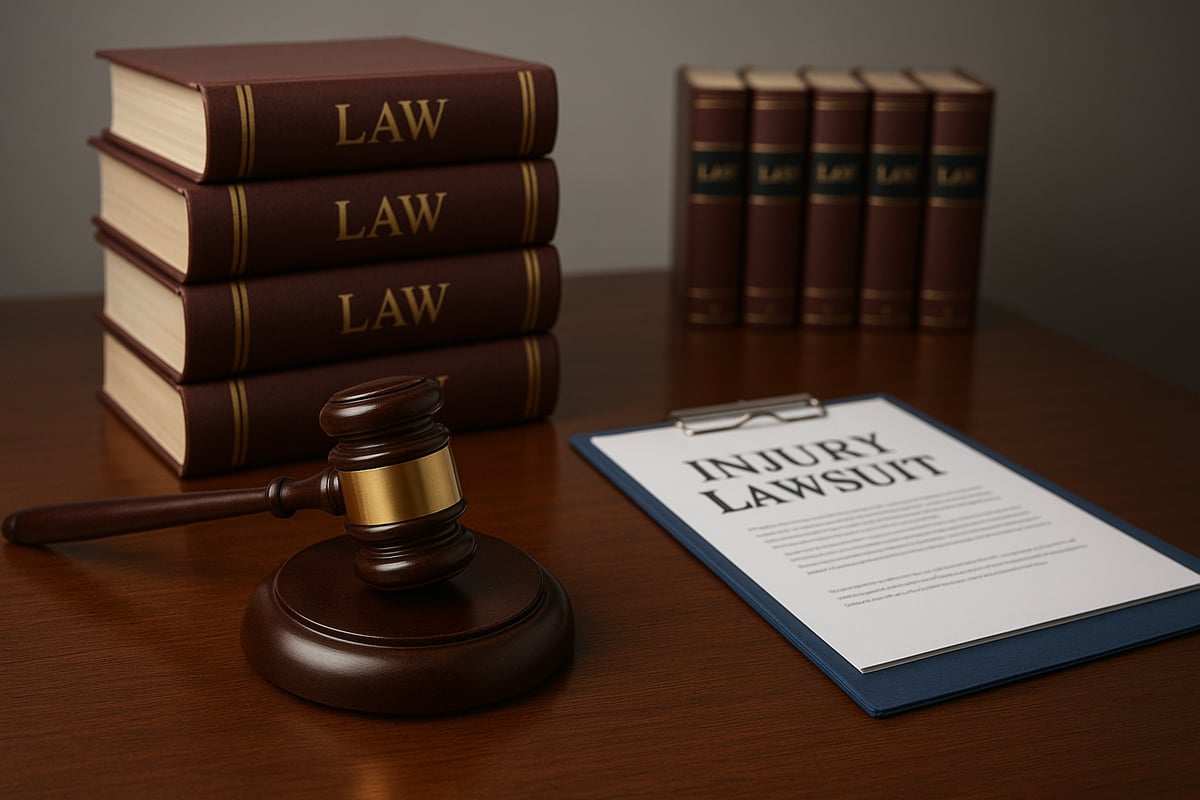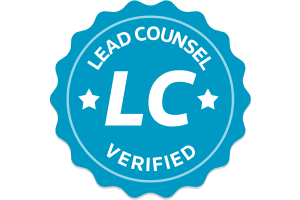- Free Consultation: 866-966-5240 Tap Here To Call Us
7 Key Facts to Know Before Filing an Injury Lawsuit in 2025
Did you know that 95 to 96 percent of cases settle before reaching trial? This means preparation is your most valuable asset. Learning the essential facts will help you make informed choices and boost your chances of a successful outcome.
In this guide, discover the seven key facts every plaintiff must know before moving forward.
Understanding the Basics of Injury Lawsuits
Personal injury lawsuits are a cornerstone of civil justice, offering a pathway for individuals to seek compensation after suffering harm. Whether from a car accident, slip and fall, or another event, understanding the essentials before pursuing an injury lawsuit is vital. Let’s break down what qualifies as an injury lawsuit and what to expect from the legal journey ahead.
What Qualifies as a Personal Injury Lawsuit?
An injury lawsuit is a legal claim filed by someone who has been harmed due to another party’s negligence or intentional act. Common types include car accidents, slip and fall incidents, medical malpractice, and product liability cases. To succeed in an injury lawsuit, the plaintiff must prove that the defendant owed a duty of care, breached that duty, and directly caused damages.
Damages awarded in an injury lawsuit can include compensation for medical expenses, lost wages, and pain and suffering. For example, car accidents are the most frequent basis for an injury lawsuit, and statistics show plaintiffs succeed in about 61 percent of these cases. Settling is often preferred, as it provides certainty and can resolve matters faster than a trial. However, some cases, such as wrongful death or catastrophic injuries, may involve unique legal standards or higher compensation.
Acting quickly after an injury is crucial because waiting can jeopardize evidence and your legal rights. According to the Personal Injury Claims FAQs, understanding what steps to take immediately can have a significant impact on your injury lawsuit’s outcome. Consulting an attorney early helps ensure all deadlines and procedures are properly followed.
The Legal Process: What to Expect
The journey of an injury lawsuit follows several key steps. It begins with the injury itself, followed by seeking medical attention and hiring a qualified lawyer. The attorney then investigates the facts, gathers evidence, and enters pre-suit negotiations with the responsible party or their insurer.
If a settlement is not reached, the injury lawsuit proceeds to formal filing and the discovery phase. This stage, where both sides exchange information and build their cases, can last up to a year. Most injury lawsuit cases—up to 96 percent—are resolved before reaching trial. However, if no agreement is reached, the case may proceed to court, where a judge or jury decides the outcome. Appeals can further extend the process.
Litigation can be emotionally and financially taxing. Plaintiffs may face stress, delays, and uncertainty about the final result. Throughout, attorneys play a vital role in guiding clients, managing communication, and advocating for their best interests at every stage of the injury lawsuit process.
7 Key Facts to Know Before Filing an Injury Lawsuit in 2025
Filing an injury lawsuit in 2025 means navigating a complex and evolving legal environment. To maximize your chance of success, you must be prepared, informed, and strategic. Here are seven crucial facts every plaintiff should know before moving forward.
1. Statute of Limitations: Don’t Miss Critical Deadlines
The statute of limitations is the legal deadline to initiate an injury lawsuit. Missing this window means losing the right to seek compensation, no matter how strong your case is.
For most injury lawsuit types, the statute of limitations is two years from the date of the incident. However, this timeframe varies by state and type of claim. For example, medical malpractice or product liability claims may have different deadlines.
Certain exceptions exist. If the injured party is a minor, the clock may not start until they turn 18. In cases where the injury is discovered later, such as internal injuries from a faulty product, the deadline can be extended. Claims against government agencies usually have much shorter timeframes, sometimes as little as six months.
Failing to file your injury lawsuit within the statute of limitations results in automatic dismissal. In 2025, some states have updated their statutes, so it is critical to confirm the current rules in your jurisdiction. For instance, California recently clarified rules for delayed discovery, while Texas adjusted timelines for specific injury lawsuit categories.
Act quickly after an accident. Preserve your right to pursue an injury lawsuit by consulting an attorney promptly. Legal professionals track deadlines and ensure all paperwork is filed on time, protecting your claim from being barred.
Timeliness is not just a technicality, it is a foundational requirement in every injury lawsuit. Take immediate action to safeguard your legal options.
2. Evidence Collection is Crucial for Success
The strength of your injury lawsuit depends on the quality and quantity of evidence you present. Courts and insurance companies rely on solid proof to determine fault and assess damages.
Essential evidence includes:
- Medical records detailing your injuries and treatment
- Police and incident reports
- Photographs of the accident scene, injuries, and property damage
- Witness statements and contact information
- Expert testimony (e.g., accident reconstructionists or medical experts)
- Digital evidence such as security camera footage, text messages, or emails
Proper evidence collection can make or break an injury lawsuit. For example, missing medical documentation or incomplete witness statements often lead to denied claims. In some cases, lack of timely photos or videos has resulted in lost compensation opportunities.
To maximize your injury lawsuit’s success, start gathering documentation immediately after the incident. Store all receipts, bills, and correspondence in a secure place. If evidence is at risk of being lost (such as surveillance footage), your attorney can issue subpoenas to preserve it.
Best practices include:
- Documenting injuries as they progress
- Keeping a pain diary
- Backing up digital files
- Requesting copies of all relevant records
Attorneys play a vital role in collecting, organizing, and presenting evidence. Their experience with subpoenas and expert witnesses can significantly strengthen your injury lawsuit.
3. Insurance Companies Are Not on Your Side
Most injury lawsuit settlements involve insurance companies, but it is crucial to remember that their interests are not aligned with yours. Their goal is to minimize payouts and protect their bottom line.
Common insurance tactics include:
- Offering low initial settlements
- Delaying claim processing
- Denying valid claims on technicalities
- Requesting recorded statements that may be used against you
Do not accept the first offer. Insurance adjusters are trained negotiators who may pressure you to settle quickly, often before the full extent of your injuries is known. In fact, research shows that most injury lawsuit settlements are significantly higher when claimants are represented by attorneys.
Before speaking with insurers, consult a lawyer. They can advise you on what to say, help you understand your policy limits, and negotiate from a position of strength. Knowing your rights and the details of your coverage is essential for a fair outcome.
Insurance adjusters may seem friendly, but their incentives are tied to saving their company money. Stand firm, document all communications, and never sign anything without legal review. Your injury lawsuit deserves a level playing field.
4. The Role of Legal Representation: Why Hiring a Lawyer Matters
Hiring an attorney can make a profound difference in the outcome of your injury lawsuit. Studies consistently show that plaintiffs with legal representation recover higher settlements and verdicts compared to those who go it alone.
Most personal injury attorneys work on a contingency fee basis. This means you pay nothing upfront, and the lawyer only gets paid if you win your injury lawsuit. This arrangement aligns your interests and makes legal help accessible for most people.
During your initial consultation, expect the attorney to:
- Review the facts of your case
- Outline possible legal strategies
- Estimate potential compensation
- Explain the litigation process
Attorneys handle negotiations, investigate facts, and represent you in court if needed. Their experience in evaluating evidence, dealing with insurance companies, and understanding local court rules is invaluable.
Choose a reputable lawyer with a track record in injury lawsuit cases. The right attorney increases your chances of a favorable outcome and can alleviate much of the stress associated with litigation.
5. Settlement vs. Trial: Weighing Your Options
Most injury lawsuit cases resolve through settlement, not trial. Statistics show that only 4 to 5 percent of these cases go before a jury, and about half of plaintiffs win at trial.
Settling an injury lawsuit offers several advantages:
- Faster resolution
- Greater certainty and control over the outcome
- Privacy, as settlements are typically confidential
However, going to trial may be necessary if the defendant refuses to offer fair compensation. Trials also come with risks, including unpredictable jury decisions, higher costs, and longer timelines.
During settlement talks, parties may engage in mediation or direct negotiation. Your attorney will guide you through the process, help you evaluate offers, and advise on whether to accept or proceed to trial.
Here is a comparison table for quick reference:
| Option | Pros | Cons |
|---|---|---|
| Settlement | Quick, private, certain | May be lower compensation |
| Trial | Potentially higher award | Risky, time-consuming, costly |
Discuss all options with your attorney. They will provide insight into likely outcomes based on your specific injury lawsuit circumstances.
6. Calculating Damages: What Compensation Can You Expect?
Understanding how damages are calculated is essential for any injury lawsuit. Compensation typically falls into three categories:
- Economic damages: medical bills, lost wages, rehabilitation costs
- Non-economic damages: pain and suffering, emotional distress
- Punitive damages: awarded in cases of egregious misconduct
Damages are calculated using medical records, pay stubs, expert testimony, and evidence of long-term impact. Factors such as injury severity, liability clarity, and the injured party’s age can all influence the final amount.
For example, the average settlement for a car accident injury lawsuit may range from $20,000 to $50,000, while catastrophic injuries can result in much higher awards. Some states, like California, have caps on non-economic damages, especially in medical malpractice cases.
Documentation is key. Keep detailed records of all expenses and losses. Expert witnesses may be needed to prove future medical needs or loss of earning capacity.
For recent data on settlement amounts and case outcomes, you can review Personal Injury Law Statistics for 2025, which highlights significant verdicts and trends.
Set realistic expectations. Your attorney will help you understand the potential range of compensation for your injury lawsuit and prepare the strongest case possible.
7. The Emotional and Financial Realities of Lawsuits
Filing an injury lawsuit can be emotionally and financially challenging. Litigation often involves months or even years of waiting, uncertainty, and stress.
The emotional toll may include:
- Anxiety about medical recovery and legal outcomes
- Strain on personal relationships
- Frustration with delays and complex procedures
Financially, plaintiffs must consider:
- Attorney fees (typically a percentage of the recovery)
- Costs for expert witnesses, court filings, and medical reports
- Delays in receiving compensation, especially if appeals or post-judgment collection are involved
Some injury lawsuit plaintiffs face wage garnishments or difficulty collecting judgments, particularly if the defendant lacks insurance or assets.
Prepare by building a support system, such as family, friends, or counselors. Many communities offer resources for plaintiffs navigating the legal process. Your attorney can also recommend strategies for managing costs and emotional stress.
Understanding these realities helps you approach your injury lawsuit with clear expectations and resilience.
Recent Changes in Personal Injury Law for 2025
The landscape of injury lawsuit cases is experiencing significant transformation in 2025. With evolving laws and shifting court decisions, plaintiffs and their attorneys must stay proactive to protect their rights. Understanding these recent changes is crucial for anyone considering an injury lawsuit in today’s legal environment.
New Legislative Developments
Several states have updated their statutes of limitations for filing an injury lawsuit. In 2025, some jurisdictions have shortened the timeframe to file, while others have added exceptions for delayed discovery. Notably, new regulations in major states now require earlier notice for claims involving government entities. Damage caps have also shifted, with legislatures in certain regions increasing the maximum amount a plaintiff can recover for non-economic losses, such as pain and suffering. Courts have clarified procedural rules, making it essential to consult recent state laws before starting an injury lawsuit.
Trends in Settlements, Juries, and Insurance
As injury lawsuit trends evolve, settlement amounts and jury perspectives have shifted. Data shows that the average settlement for car accident claims and slip and fall cases has increased slightly nationwide. Jury attitudes are also changing, with some regions seeing higher awards for catastrophic injuries, while others remain conservative. Insurance companies, responding to these changes, are adjusting their negotiation strategies and policy limits. For detailed statistics and industry trends, visit Personal Injury Law Statistics and Industry Trends for 2025.
Recent Court Decisions and Case Examples
Recent appellate decisions have influenced how courts interpret liability, especially in complex injury lawsuit cases. For instance, rulings in several states now allow for expanded discovery of digital evidence, affecting both plaintiffs and defendants. Some cases have set new precedents for how future damages are calculated, directly impacting compensation expectations. These developments highlight the importance of staying informed about legal precedent when considering an injury lawsuit.
State-Specific Updates and Staying Informed
Major jurisdictions like California have enacted noteworthy changes in injury lawsuit procedures. New requirements for pre-suit mediation and stricter documentation standards are now in place. For ongoing updates and in-depth analysis of California’s evolving laws, refer to the California Personal Injury Law Blog. Because laws and trends can shift quickly, anyone contemplating an injury lawsuit should regularly consult legal experts or reputable resources. This ensures that your approach remains current and maximizes your chances for a successful outcome.
How to Choose the Right Personal Injury Lawyer
Selecting the right attorney is one of the most important steps when pursuing an injury lawsuit. The lawyer you choose can directly impact your case outcome, your compensation, and your overall experience. With so much at stake, investing time in this decision is essential.
What to Look for in a Personal Injury Lawyer
Start by focusing on experience and specialization. A lawyer who regularly handles cases similar to your injury lawsuit, such as car accidents or slip and fall claims, will know the nuances of your case type. For instance, if your injury lawsuit involves a car accident, you might want someone familiar with the process outlined in Car Accident Claims in California.
Review the attorney’s track record. Look for a history of successful settlements and verdicts, especially those similar to your injury lawsuit. Client reviews and testimonials provide valuable insight into the lawyer’s communication style and dedication. Recognitions, awards, and professional memberships are also positive indicators of expertise.
Local knowledge is crucial because injury lawsuit procedures and laws can vary by state or city. Choosing a lawyer with strong local experience ensures they understand the specific rules and trends in your jurisdiction. Always consider attorneys who offer free consultations and work on a contingency fee basis, so you pay nothing upfront.
Questions to Ask and Red Flags to Avoid
Prepare a list of questions for your initial consultation. Ask about their experience with your type of injury lawsuit, their approach to negotiation and litigation, and their recent case results. Reviewing case outcomes, such as those found in Texas Personal Injury Settlement Amounts and Statistics (2025), can help you understand what to expect.
Be alert for red flags. Avoid lawyers who are vague about their track record, avoid your questions, or pressure you to sign quickly. Poor communication, lack of transparency about fees, or negative client feedback are also warning signs.
A strong attorney-client relationship is vital. Your lawyer should make you feel heard, respected, and confident throughout the injury lawsuit process. Take the time to find someone who aligns with your needs and values, as this partnership will be key to a successful outcome.
As you consider the key facts before filing an injury lawsuit in 2025, remember that having the right legal support can make all the difference. Navigating statutes of limitations, gathering evidence, and dealing with insurance companies is challenging—especially while recovering from an injury. You deserve clear guidance and an advocate who puts your interests first. If you have questions or are unsure about your next steps, we’re here to help. Reach out today for a Free Consultation No Fee Until We Win and let us guide you toward the best possible outcome.
The number of injury lawsuits is rising fast in 2025, putting more lives, finances, and futures on the line than ever before. With such high stakes, understanding the legal landscape before filing an injury lawsuit can make all the difference.
Did you know that 95 to 96 percent of cases settle before reaching trial? This means preparation is your most valuable asset. Learning the essential facts will help you make informed choices and boost your chances of a successful outcome.
In this guide, discover the seven key facts every plaintiff must know before moving forward.
Understanding the Basics of Injury Lawsuits
Personal injury lawsuits are a cornerstone of civil justice, offering a pathway for individuals to seek compensation after suffering harm. Whether from a car accident, slip and fall, or another event, understanding the essentials before pursuing an injury lawsuit is vital. Let’s break down what qualifies as an injury lawsuit and what to expect from the legal journey ahead.
What Qualifies as a Personal Injury Lawsuit?
An injury lawsuit is a legal claim filed by someone who has been harmed due to another party’s negligence or intentional act. Common types include car accidents, slip and fall incidents, medical malpractice, and product liability cases. To succeed in an injury lawsuit, the plaintiff must prove that the defendant owed a duty of care, breached that duty, and directly caused damages.
Damages awarded in an injury lawsuit can include compensation for medical expenses, lost wages, and pain and suffering. For example, car accidents are the most frequent basis for an injury lawsuit, and statistics show plaintiffs succeed in about 61 percent of these cases. Settling is often preferred, as it provides certainty and can resolve matters faster than a trial. However, some cases, such as wrongful death or catastrophic injuries, may involve unique legal standards or higher compensation.
Acting quickly after an injury is crucial because waiting can jeopardize evidence and your legal rights. According to the Personal Injury Claims FAQs, understanding what steps to take immediately can have a significant impact on your injury lawsuit’s outcome. Consulting an attorney early helps ensure all deadlines and procedures are properly followed.
The Legal Process: What to Expect
The journey of an injury lawsuit follows several key steps. It begins with the injury itself, followed by seeking medical attention and hiring a qualified lawyer. The attorney then investigates the facts, gathers evidence, and enters pre-suit negotiations with the responsible party or their insurer.
If a settlement is not reached, the injury lawsuit proceeds to formal filing and the discovery phase. This stage, where both sides exchange information and build their cases, can last up to a year. Most injury lawsuit cases—up to 96 percent—are resolved before reaching trial. However, if no agreement is reached, the case may proceed to court, where a judge or jury decides the outcome. Appeals can further extend the process.
Litigation can be emotionally and financially taxing. Plaintiffs may face stress, delays, and uncertainty about the final result. Throughout, attorneys play a vital role in guiding clients, managing communication, and advocating for their best interests at every stage of the injury lawsuit process.
7 Key Facts to Know Before Filing an Injury Lawsuit in 2025
Filing an injury lawsuit in 2025 means navigating a complex and evolving legal environment. To maximize your chance of success, you must be prepared, informed, and strategic. Here are seven crucial facts every plaintiff should know before moving forward.
1. Statute of Limitations: Don’t Miss Critical Deadlines
The statute of limitations is the legal deadline to initiate an injury lawsuit. Missing this window means losing the right to seek compensation, no matter how strong your case is.
For most injury lawsuit types, the statute of limitations is two years from the date of the incident. However, this timeframe varies by state and type of claim. For example, medical malpractice or product liability claims may have different deadlines.
Certain exceptions exist. If the injured party is a minor, the clock may not start until they turn 18. In cases where the injury is discovered later, such as internal injuries from a faulty product, the deadline can be extended. Claims against government agencies usually have much shorter timeframes, sometimes as little as six months.
Failing to file your injury lawsuit within the statute of limitations results in automatic dismissal. In 2025, some states have updated their statutes, so it is critical to confirm the current rules in your jurisdiction. For instance, California recently clarified rules for delayed discovery, while Texas adjusted timelines for specific injury lawsuit categories.
Act quickly after an accident. Preserve your right to pursue an injury lawsuit by consulting an attorney promptly. Legal professionals track deadlines and ensure all paperwork is filed on time, protecting your claim from being barred.
Timeliness is not just a technicality, it is a foundational requirement in every injury lawsuit. Take immediate action to safeguard your legal options.
2. Evidence Collection is Crucial for Success
The strength of your injury lawsuit depends on the quality and quantity of evidence you present. Courts and insurance companies rely on solid proof to determine fault and assess damages.
Essential evidence includes:
- Medical records detailing your injuries and treatment
- Police and incident reports
- Photographs of the accident scene, injuries, and property damage
- Witness statements and contact information
- Expert testimony (e.g., accident reconstructionists or medical experts)
- Digital evidence such as security camera footage, text messages, or emails
Proper evidence collection can make or break an injury lawsuit. For example, missing medical documentation or incomplete witness statements often lead to denied claims. In some cases, lack of timely photos or videos has resulted in lost compensation opportunities.
To maximize your injury lawsuit’s success, start gathering documentation immediately after the incident. Store all receipts, bills, and correspondence in a secure place. If evidence is at risk of being lost (such as surveillance footage), your attorney can issue subpoenas to preserve it.
Best practices include:
- Documenting injuries as they progress
- Keeping a pain diary
- Backing up digital files
- Requesting copies of all relevant records
Attorneys play a vital role in collecting, organizing, and presenting evidence. Their experience with subpoenas and expert witnesses can significantly strengthen your injury lawsuit.
3. Insurance Companies Are Not on Your Side
Most injury lawsuit settlements involve insurance companies, but it is crucial to remember that their interests are not aligned with yours. Their goal is to minimize payouts and protect their bottom line.
Common insurance tactics include:
- Offering low initial settlements
- Delaying claim processing
- Denying valid claims on technicalities
- Requesting recorded statements that may be used against you
Do not accept the first offer. Insurance adjusters are trained negotiators who may pressure you to settle quickly, often before the full extent of your injuries is known. In fact, research shows that most injury lawsuit settlements are significantly higher when claimants are represented by attorneys.
Before speaking with insurers, consult a lawyer. They can advise you on what to say, help you understand your policy limits, and negotiate from a position of strength. Knowing your rights and the details of your coverage is essential for a fair outcome.
Insurance adjusters may seem friendly, but their incentives are tied to saving their company money. Stand firm, document all communications, and never sign anything without legal review. Your injury lawsuit deserves a level playing field.
4. The Role of Legal Representation: Why Hiring a Lawyer Matters
Hiring an attorney can make a profound difference in the outcome of your injury lawsuit. Studies consistently show that plaintiffs with legal representation recover higher settlements and verdicts compared to those who go it alone.
Most personal injury attorneys work on a contingency fee basis. This means you pay nothing upfront, and the lawyer only gets paid if you win your injury lawsuit. This arrangement aligns your interests and makes legal help accessible for most people.
During your initial consultation, expect the attorney to:
- Review the facts of your case
- Outline possible legal strategies
- Estimate potential compensation
- Explain the litigation process
Attorneys handle negotiations, investigate facts, and represent you in court if needed. Their experience in evaluating evidence, dealing with insurance companies, and understanding local court rules is invaluable.
Choose a reputable lawyer with a track record in injury lawsuit cases. The right attorney increases your chances of a favorable outcome and can alleviate much of the stress associated with litigation.
5. Settlement vs. Trial: Weighing Your Options
Most injury lawsuit cases resolve through settlement, not trial. Statistics show that only 4 to 5 percent of these cases go before a jury, and about half of plaintiffs win at trial.
Settling an injury lawsuit offers several advantages:
- Faster resolution
- Greater certainty and control over the outcome
- Privacy, as settlements are typically confidential
However, going to trial may be necessary if the defendant refuses to offer fair compensation. Trials also come with risks, including unpredictable jury decisions, higher costs, and longer timelines.
During settlement talks, parties may engage in mediation or direct negotiation. Your attorney will guide you through the process, help you evaluate offers, and advise on whether to accept or proceed to trial.
Here is a comparison table for quick reference:
| Option | Pros | Cons |
|---|---|---|
| Settlement | Quick, private, certain | May be lower compensation |
| Trial | Potentially higher award | Risky, time-consuming, costly |
Discuss all options with your attorney. They will provide insight into likely outcomes based on your specific injury lawsuit circumstances.
6. Calculating Damages: What Compensation Can You Expect?
Understanding how damages are calculated is essential for any injury lawsuit. Compensation typically falls into three categories:
- Economic damages: medical bills, lost wages, rehabilitation costs
- Non-economic damages: pain and suffering, emotional distress
- Punitive damages: awarded in cases of egregious misconduct
Damages are calculated using medical records, pay stubs, expert testimony, and evidence of long-term impact. Factors such as injury severity, liability clarity, and the injured party’s age can all influence the final amount.
For example, the average settlement for a car accident injury lawsuit may range from $20,000 to $50,000, while catastrophic injuries can result in much higher awards. Some states, like California, have caps on non-economic damages, especially in medical malpractice cases.
Documentation is key. Keep detailed records of all expenses and losses. Expert witnesses may be needed to prove future medical needs or loss of earning capacity.
For recent data on settlement amounts and case outcomes, you can review Personal Injury Law Statistics for 2025, which highlights significant verdicts and trends.
Set realistic expectations. Your attorney will help you understand the potential range of compensation for your injury lawsuit and prepare the strongest case possible.
7. The Emotional and Financial Realities of Lawsuits
Filing an injury lawsuit can be emotionally and financially challenging. Litigation often involves months or even years of waiting, uncertainty, and stress.
The emotional toll may include:
- Anxiety about medical recovery and legal outcomes
- Strain on personal relationships
- Frustration with delays and complex procedures
Financially, plaintiffs must consider:
- Attorney fees (typically a percentage of the recovery)
- Costs for expert witnesses, court filings, and medical reports
- Delays in receiving compensation, especially if appeals or post-judgment collection are involved
Some injury lawsuit plaintiffs face wage garnishments or difficulty collecting judgments, particularly if the defendant lacks insurance or assets.
Prepare by building a support system, such as family, friends, or counselors. Many communities offer resources for plaintiffs navigating the legal process. Your attorney can also recommend strategies for managing costs and emotional stress.
Understanding these realities helps you approach your injury lawsuit with clear expectations and resilience.
Recent Changes in Personal Injury Law for 2025
The landscape of injury lawsuit cases is experiencing significant transformation in 2025. With evolving laws and shifting court decisions, plaintiffs and their attorneys must stay proactive to protect their rights. Understanding these recent changes is crucial for anyone considering an injury lawsuit in today’s legal environment.
New Legislative Developments
Several states have updated their statutes of limitations for filing an injury lawsuit. In 2025, some jurisdictions have shortened the timeframe to file, while others have added exceptions for delayed discovery. Notably, new regulations in major states now require earlier notice for claims involving government entities. Damage caps have also shifted, with legislatures in certain regions increasing the maximum amount a plaintiff can recover for non-economic losses, such as pain and suffering. Courts have clarified procedural rules, making it essential to consult recent state laws before starting an injury lawsuit.
Trends in Settlements, Juries, and Insurance
As injury lawsuit trends evolve, settlement amounts and jury perspectives have shifted. Data shows that the average settlement for car accident claims and slip and fall cases has increased slightly nationwide. Jury attitudes are also changing, with some regions seeing higher awards for catastrophic injuries, while others remain conservative. Insurance companies, responding to these changes, are adjusting their negotiation strategies and policy limits. For detailed statistics and industry trends, visit Personal Injury Law Statistics and Industry Trends for 2025.
Recent Court Decisions and Case Examples
Recent appellate decisions have influenced how courts interpret liability, especially in complex injury lawsuit cases. For instance, rulings in several states now allow for expanded discovery of digital evidence, affecting both plaintiffs and defendants. Some cases have set new precedents for how future damages are calculated, directly impacting compensation expectations. These developments highlight the importance of staying informed about legal precedent when considering an injury lawsuit.
State-Specific Updates and Staying Informed
Major jurisdictions like California have enacted noteworthy changes in injury lawsuit procedures. New requirements for pre-suit mediation and stricter documentation standards are now in place. For ongoing updates and in-depth analysis of California’s evolving laws, refer to the California Personal Injury Law Blog. Because laws and trends can shift quickly, anyone contemplating an injury lawsuit should regularly consult legal experts or reputable resources. This ensures that your approach remains current and maximizes your chances for a successful outcome.
How to Choose the Right Personal Injury Lawyer
Selecting the right attorney is one of the most important steps when pursuing an injury lawsuit. The lawyer you choose can directly impact your case outcome, your compensation, and your overall experience. With so much at stake, investing time in this decision is essential.
What to Look for in a Personal Injury Lawyer
Start by focusing on experience and specialization. A lawyer who regularly handles cases similar to your injury lawsuit, such as car accidents or slip and fall claims, will know the nuances of your case type. For instance, if your injury lawsuit involves a car accident, you might want someone familiar with the process outlined in Car Accident Claims in California.
Review the attorney’s track record. Look for a history of successful settlements and verdicts, especially those similar to your injury lawsuit. Client reviews and testimonials provide valuable insight into the lawyer’s communication style and dedication. Recognitions, awards, and professional memberships are also positive indicators of expertise.
Local knowledge is crucial because injury lawsuit procedures and laws can vary by state or city. Choosing a lawyer with strong local experience ensures they understand the specific rules and trends in your jurisdiction. Always consider attorneys who offer free consultations and work on a contingency fee basis, so you pay nothing upfront.
Questions to Ask and Red Flags to Avoid
Prepare a list of questions for your initial consultation. Ask about their experience with your type of injury lawsuit, their approach to negotiation and litigation, and their recent case results. Reviewing case outcomes, such as those found in Texas Personal Injury Settlement Amounts and Statistics (2025), can help you understand what to expect.
Be alert for red flags. Avoid lawyers who are vague about their track record, avoid your questions, or pressure you to sign quickly. Poor communication, lack of transparency about fees, or negative client feedback are also warning signs.
A strong attorney-client relationship is vital. Your lawyer should make you feel heard, respected, and confident throughout the injury lawsuit process. Take the time to find someone who aligns with your needs and values, as this partnership will be key to a successful outcome.
As you consider the key facts before filing an injury lawsuit in 2025, remember that having the right legal support can make all the difference. Navigating statutes of limitations, gathering evidence, and dealing with insurance companies is challenging—especially while recovering from an injury. You deserve clear guidance and an advocate who puts your interests first. If you have questions or are unsure about your next steps, we’re here to help. Reach out today for a Free Consultation No Fee Until We Win and let us guide you toward the best possible outcome.












